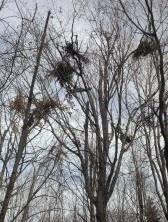Even Bears Build Nests
Its that time of the year where winter is fast approaching. There is an urgency in the woods where those animals that rely on food caches ( beavers, muskrats, squirrels) or those that hibernate (bears) are working overtime to prepare for the long months of cold and snow.
Bears prepare for winter by eating as much as they can in a short period of time. Being omnivorous they will eat anything that they can find that is palatable. Unfortunately in more urban areas this includes garbage.

Bears are aware of this and travel, during the early fall, to the same stands of beech year after year. Mother bears will show their cubs where these stands are so that generations of bears will use the same trees for feeding. They will climb the best mast producing trees and sit for hours in the crowns pullling the branches that have nuts towards themselves. As they do so they strip the branches of the nuts. With bears there is no gentle approach. As they strip the branch of nuts they also scrape off leaves and buds. All of this is then gobbled up. When doing this they create “nests” in the beech trees. I’ve heard of stories where bears will hang out in a tree all day stripping the crown of all of its nuts. Once satiated, they will sleep there for hours afterwards. The picture above was taken of a beech tree that had a number of “nests” in them. This was on a ridge top in northern NH where hundreds of beech trees were present. Many but not all of the beech trees had nests in them. It was obvious from the presence of the nests which trees were good mast producers and which ones weren’t.
So the next time you see a bird building a nest, remember that bears do too, only their nest is for feeding and not for the raising of young.











